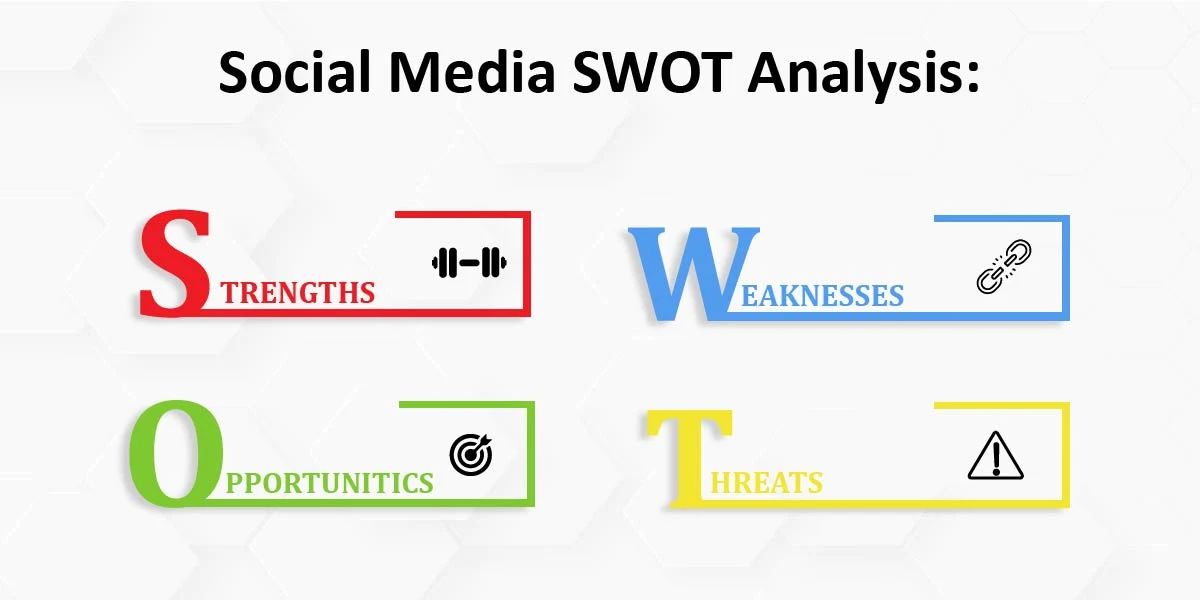Social media is one of the most powerful tools for businesses and individuals to connect with their audience, build a brand, and drive engagement. But simply being active on social platforms isn’t enough—you need a clear strategy. That’s where a Social Media SWOT Analysis comes in.
By breaking down your Strengths, Weaknesses, Opportunities, and Threats, you can get a clear picture of what’s working, what needs improvement, and how to grow your online presence effectively.
What Is a Social Media SWOT Analysis?
A Social Media SWOT Analysis helps you assess your current social media strategy so you can make smarter decisions. It’s a simple but effective way to:
✔ Identify what’s driving success
✔ Pinpoint areas that need work
✔ Spot opportunities to grow
✔ Avoid potential pitfalls
Let’s dive into each section so you can start improving your social media game today.
How to Conduct a Social Media SWOT Analysis
1. Strengths – What’s Working for You?
First, take a good look at what’s going well. These are the things you should keep doing (or do even more of!).
🔹 Brand Awareness & Recognition – Do people recognize and engage with your brand? Are you growing a loyal following?
🔹 High-Quality Content – Is your content valuable, interesting, and aligned with your brand’s voice?
🔹 Strong Engagement – Are your posts sparking conversations? Are people liking, sharing, and commenting?
🔹 Effective Use of Platforms – Are you making the most of different platforms? Do you know which ones work best for your audience?
2. Weaknesses – Where Can You Improve?
Now, let’s be honest about where you’re struggling. Identifying weaknesses helps you make meaningful improvements.
⚠ Inconsistent Posting – Do you post regularly, or are there long gaps in your content schedule?
⚠ Limited Resources – Are you struggling to manage your social media due to lack of time, tools, or a team?
⚠ Low Engagement – Are your posts getting little to no interaction? If people aren’t engaging, something needs to change.
⚠ Negative Feedback – Are there recurring complaints or criticisms? How are you handling them?
3. Opportunities – What Can You Take Advantage Of?
Look for opportunities to grow and improve. These could be new trends, audiences, or strategies you haven’t tapped into yet.
🚀 Emerging Trends – Are there new features (like Instagram Reels or LinkedIn Newsletters) that you can use to your advantage?
🚀 Expanding Your Audience – Could you reach new demographics or a niche market that aligns with your brand?
🚀 Collaborations & Influencer Partnerships – Are there influencers or brands you could collaborate with to boost your reach?
🚀 New Content Strategies – Could you experiment with different content formats, such as short videos, live streams, or interactive posts?
4. Threats – What Could Hold You Back?
Lastly, consider any external factors that could slow you down or hurt your social media presence.
⚡ Competition – Are your competitors outperforming you? What are they doing differently?
⚡ Algorithm Changes – Are social media updates affecting your reach? How can you adapt?
⚡ Reputation Risks – Could a PR crisis, bad reviews, or negative comments damage your brand? Do you have a plan for handling them?
⚡ Privacy & Compliance Issues – Are you staying up to date with data protection laws like GDPR and CCPA?
Turning Insights into Action
Once you’ve completed your SWOT analysis, it’s time to take action:
✔ Double down on your strengths – If engagement is high on certain types of content, create more of it.
✔ Fix your weaknesses – If posting is inconsistent, create a content calendar to stay on track.
✔ Seize opportunities – If a new trend aligns with your brand, jump on it before your competitors do.
✔ Prepare for threats – Stay flexible and have a plan in place for any potential risks.
Conclusion
A Social Media SWOT Analysis isn’t just a one-time exercise—it’s something you should revisit regularly to keep improving. Social media changes fast, and staying ahead means constantly evaluating what’s working, what’s not, and what’s next.
By understanding your strengths, addressing your weaknesses, and capitalizing on opportunities, you can build a stronger, more effective social media presence that keeps you ahead of the competition.
Now, take a step back, analyze your strategy, and start making the changes that will help you grow! 🚀




